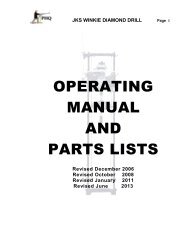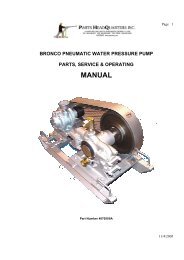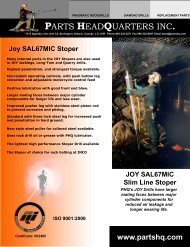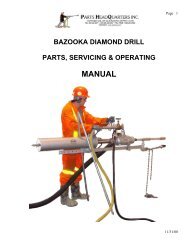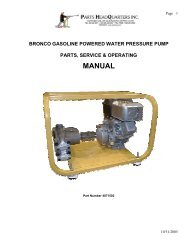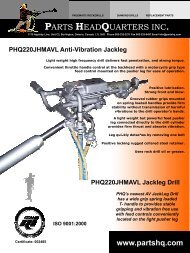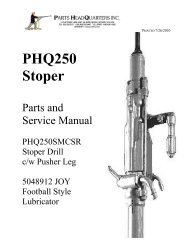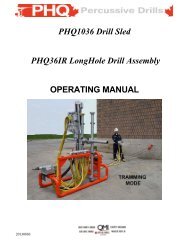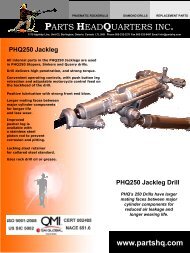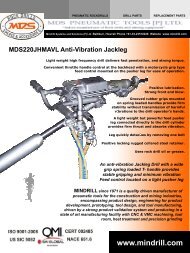PHQ250JHMAVL Jackleg MK 1 Parts and Repair Manual PDF
PHQ250JHMAVL Jackleg MK 1 Parts and Repair Manual PDF
PHQ250JHMAVL Jackleg MK 1 Parts and Repair Manual PDF
You also want an ePaper? Increase the reach of your titles
YUMPU automatically turns print PDFs into web optimized ePapers that Google loves.
Page 32<br />
Rotate the control h<strong>and</strong>le forward so the piston in the built in cylinder pushes the drill forward<br />
Run the drill under full leg pressure at partial throttle for no more than 15 minutes.<br />
Running the drill under controlled conditions in the shop accomplishes several things:<br />
The rifle bar polishes the bronze of the rifle nut.<br />
The piston splines polish the bronze of the chuck driver nut.<br />
The drill doctor listens for irregular sounds <strong>and</strong> to be sure the drill runs smoothly.<br />
The drill doctor places his h<strong>and</strong> on the cylinder of the drill near where the front head<br />
joins the cylinder to check for heat that may be generated<br />
If the drill sounds smooth during the running <strong>and</strong> the body remains fairly cool to the touch during<br />
<strong>and</strong> after the run in period the Rock Drill Doctor can be satisfied that the repairs were done<br />
properly <strong>and</strong> that the drill is running properly. This ensures smoother running later on when the<br />
drill is run at full throttle in actual drilling operations.<br />
The drill is now ready for torque testing <strong>and</strong> already in the proper position on the test bench.<br />
Testing the <strong>Jackleg</strong><br />
Remove spring loaded shank steel assembly from the bench <strong>and</strong> replace with the torque test head<br />
Before engaging the drill to the head make sure the torque head is “loosened off” at least five<br />
rotations. This will allow the drill revolution to build up momentum going into the torque test.<br />
Move the drill forward with the pneumatic pusher cylinder built into the torque test bench.<br />
Insert the rod shank adapter on the torque tester into the chuck bushing <strong>and</strong> close the steel retainer<br />
Release the feed pressure on the drill by shutting off the air to the pusher leg.<br />
With the drill in position <strong>and</strong> no pusher leg pressure suddenly throw the throttle h<strong>and</strong>le forward<br />
opening the valve fully to operate the drill for a short burst at full throttle ending in a stall.<br />
Observe the reading on the air consumption gauge, which should read 5000 LPM (170 CFM).<br />
When the drill stalled the reading on the torque gauge should be minimum 2000 Nm (140 ft lbs)<br />
When testing a sinker drill, the same test procedure is used.<br />
Version 200711



